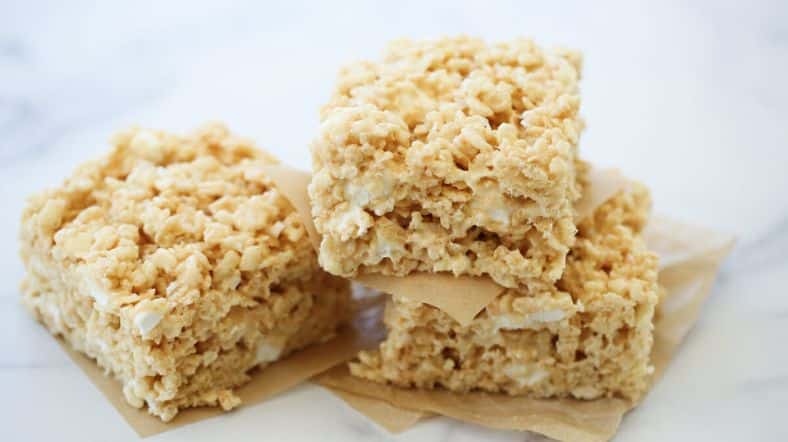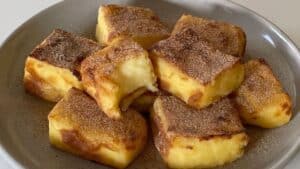You ever wonder how something as simple as a Rice Krispie treat could be elevated to downright gourmet territory? Salted caramel Rice Krispie treats do exactly that. They take a humble childhood snack and twist it into a sophisticated dessert that hits all the right notes: sweet, salty, crunchy, chewy. This ain’t your average mall food court treat. It’s a playground of textures and flavors, demanding a bit more know-how than just melting marshmallows and stirring in cereal.
If you’re a pro in the kitchen, or even just a serious home baker looking to sharpen your craft, this article will unravel the intricacies behind the perfect salted caramel Rice Krispie treat. I’ll get into the science of caramelization, balancing salt, managing moisture in the cereal, and achieving that coveted chewy yet crunchy texture. Plus, I’ll bust some myths, talk trends, and share insider tips that go way beyond your standard recipe.
Why Salted Caramel? The Flavor Alchemy
Salted caramel isn’t just a fad—it’s a flavor revolution. The contrast between sweet and salty triggers a complex reaction on our taste buds, making desserts irresistible. The salt heightens the caramel’s buttery notes and cuts through the sweetness. This balancing act is crucial because too much sugar makes the treat cloying, too little and it’s flat and boring.
Studies on flavor perception show that salt can enhance sweetness by up to 20% while reducing bitterness. That’s huge. So when you’re crafting salted caramel Rice Krispie treats, the salt isn’t just a garnish—it’s a functional flavor enhancer.
The Core Ingredient: Rice Krispies and Their Structural Role
You can’t just use any puffed rice cereal and call it a day. Rice Krispies are specifically engineered for their size, shape, and moisture absorption properties. The little hollow grains trap air and create that signature crunch. When marshmallow binds the cereal, it’s a delicate dance — too wet, and your treats get soggy; too dry, and they’re crumbly and unappealing.
Professional kitchens often test moisture content. Ideal final moisture for crispy treats is about 12-14%. Too low and the treats dry out quickly. Too high and they lose crunch in hours.
Marshmallow Magic: The Binding Agent and Its Secrets
Most folks just melt marshmallows without a second thought. But here’s where things get tricky. The type of marshmallow and the melting process can dramatically affect texture. Commercial marshmallows contain stabilizers and corn syrup, which prevent crystallization and maintain chewiness. But if you’re going artisanal, making your own marshmallow fluff or using natural ones, you might need to adjust the heat and stirring time to avoid grainy or overly sticky results.
Heat control is essential. Too high a temperature, and marshmallows scorch, creating bitterness. Too low, and they don’t melt smoothly. Ideally, melt marshmallows gently over medium-low heat with butter to add richness and prevent sticking.
The Art of Salted Caramel: Beyond Just Sugar and Salt
Caramel is deceptively simple. You cook sugar until it browns and hits a certain temperature. But those few minutes of caramelization are a rollercoaster of chemical reactions. Maillard reaction and sugar inversion occur, transforming sweet sugar into deep, nutty, buttery flavors.
Salted caramel demands precision:
- Temperature: For perfect caramel, aim for 340°F (171°C). Any hotter and it burns. Cooler, and you get a pale, flavorless syrup.
- Salt: Use flaky sea salt or Maldon salt for texture and punch. It dissolves unevenly, giving occasional bursts of saltiness rather than a flat salty taste.
- Butter and cream: Adding fat not only enriches the flavor but also controls crystallization. A little cream cools the caramel, making it creamy and less brittle.
If you skip these steps or eyeball measurements, you’ll end with caramel that’s either too thin, too hard, or just bland.
Combining Salted Caramel with Rice Krispie Treats: The Process
First, make your salted caramel sauce separately. You want it thick but pourable, not syrupy or rock-hard.
Melt your marshmallows and butter slowly. Then fold in the cereal gently to avoid crushing it.
Now, here’s the kicker: you fold the caramel in carefully. Too much stirring breaks the cereal, too little and you get uneven caramel distribution.
Some chefs drizzle caramel on top for a layered texture, while others incorporate it inside for chewiness throughout. Both have merits depending on your audience.
Addressing Common Mistakes and Misconceptions
Myth #1: More caramel = better flavor. Nope. Oversaturating the cereal kills crunch. Aim for balance.
Myth #2: Salt is just sprinkled on top. True salted caramel means salt is integrated in the caramel itself, not just tossed on the surface.
Myth #3: Rice Krispies don’t get soggy quickly. They do, unless the treat is stored properly. Air-tight containers and room temperature storage are key.
Trends and Innovations in Salted Caramel Rice Krispie Treats
Chefs and home bakers alike are experimenting with:
- Brown butter instead of regular butter for nuttier caramel notes.
- Flavored salts like smoked or pink Himalayan for a unique twist.
- Inclusions like chopped nuts, chocolate chunks, or even freeze-dried fruit for texture contrasts.
- Vegan versions using coconut oil and plant-based marshmallows are rising in popularity.
Case Study: A Bakery’s Approach to Perfecting Salted Caramel Rice Krispie Treats
Take “SweetCrave Bakery” in New York, famous for their version. They experimented for months tweaking caramel temperature, salt variety, and cereal-to-marshmallow ratio. They found using brown butter and Maldon salt gave their treats a cult following.
They also found that letting the treats rest for 12 hours before cutting allowed the caramel to set perfectly without drying out the cereal, increasing shelf life from 2 days to 5.
Final Thoughts and Pro Tips for Professionals
- Always test caramel temperature with a candy thermometer. Eyeballing it leads to inconsistency.
- Use fresh cereal. Stale cereal means soggy treats.
- When mixing, fold gently to maintain texture.
- Salt quality and quantity can’t be underestimated—experiment with different salts.
- Store in an airtight container, room temp, for max crunch and flavor.
Salted caramel Rice Krispie treats are deceptively simple but rich with complexity. Mastering them elevates your repertoire and offers your clients or customers a memorable treat they’ll crave again and again. You don’t just make snacks—you create experiences.
So get in the kitchen, perfect your caramel, and watch a classic turn into something unforgettable.









